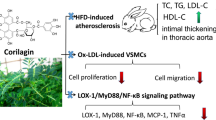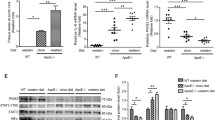Summary
To observe the effects of simvastatin on nuclear factor kappaB (NF-κB)-DNA binding activity and on the expression of monocyte chemoattractant protein-1 (MCP-1) in atherosclerotic plaque in rabbits and to explore the anti-atherosclerotic properties beyond its lipid-lowering effects. Thirty-six New Zealand male rabbits were randomly divided into low-cholesterol group (LC), high-cholesterol group (HC), high-cholesterol+simvastatin group (HC+S) and then were fed for 12 weeks. At the end of the experiment, standard enzymatic assays, electrophoretic mobility shift assay (EMSA), immunohistochemical staining, and morphometry were performed to observe serum lipids, NF-κB-DNA binding activity, MCP-1 protein expression, intima thickness and plaque area of aorta respectively in all three groups. Our results showed that the serum lipids, NF-κB-DNA binding activity, expression of MCP-1 protein, intima thickness, and plaque area of aorta in the LC and HC+S groups were significantly lower than those in the HC group (P<0.05). There was no significant difference in the serum lipids between the LC and HC+S groups (P>0.05), but the NF-κB-DNA binding activity, the expression of MCP-1 protein and the intima thickness and plaque area of aorta in the HC+S group were significantly decreased as compared to the LC group (P<0.05). This study demonstrated that simvastatin could decrease atherosclerosis by inhibiting the NF-κB-DNA binding activity and by reducing the expression of MCP-1 protein.
Similar content being viewed by others
References
Menno P J de Winther, Edwin K, Georg Ket al. Nuclear factor κB signaling in atherogenesis. Arterioscler Thromb Vasc Biol, 2005, 25: 904–914
Robert K, Hans M G P, Jef J Eet al. Rosuvastatin reduces atherosclerosis development beyond and independent of its plasma cholesterol-lowering effect in APOE* 3-Leiden transgenic mice. Circulation, 2003, 108: 1368–1374
Pu J, Wang L, Zhang C Tet al. Defibrase inhibits atherosclerosis induced by immunologic injury and high-fat diet in rabbit through restoring nitric oxide availability. Arterioscler Thromb Vasc Biol, 2004, 24: E7-E10
Dwarakanath R S, Sahar S, Reddy M Aet al. Regulation of monocyte chemoattractant protein-1 by the oxidized lipid, 13-hydroperoxyoctadecadienoic acid, in vascular smooth muscle cells via nuclear factor-kappa B (NF-kappa B). J Mol Cell Cardiol, 2004, 36(4): 585–595
Claudia M, Evangelos A, Serafim Ket al. Canonical pathway of nuclear factor κB activation selectively regulates proinflammatory and prothrombotic responses in human atherosclerosis. PNAS, 2004, 15(101): 5634–5639
Brand K, Page S, Rogler Get al. Activated Transcription factor nuclear factor-kappa B is pregant in the athcrosclerotic lesion. J Clin Invest, 1996, 97: 1715–1722
James X R, Joan W B, Mark B Tet al. Lysophosphatidylcholine stimulates monocyte chemoattractant protein-1 gene expression in rat aortic smooth muscle cells. Arterioscler Thromb Vasc Biol, 2002, 22: 1617–1623
Ikeda U, Matsui K, Murakami Yet al. Monocyte chemoattractant protein-1 and coronary artery discase. Clin Cardiol, 2002, 25: 143–147
Jacob G, Arnon A, Pnina Ket al. Functional inhibition of Ras by S-trans, trans-farnesyl thiosalicylic acid attenuates atherosclerosis in apolipoprotein E knockout mice. Circulation, 2002, 105: 2416–2422
Ortego M, Gomez-Hernandez A, Vidal Cet al. HMG-CoA reductase inhibitors reduce I kappa B kinase activity induced by oxidative stress in monocytes and vascular smooth muscle cells. J Cardiovasc Pharmacol, 2005, 45(5): 468–475
Author information
Authors and Affiliations
Additional information
YANG Xiaoyun, female, born in 1966, M. D., Ph. D.
This project was supported by a grant from the National Natural Sciences Foundation of China (No. 30470713).
Rights and permissions
About this article
Cite this article
Xiaoyun, Y., Lin, W., Hesong, Z. et al. Effects of simvastatin on NF-κB-DNA binding activity and monocyte chemoattractant protein-1 expression in a rabbit model of atherosclerosis. J. Huazhong Univ. Sci. Technol. [Med. Sci.] 26, 194–198 (2006). https://doi.org/10.1007/BF02895814
Received:
Issue Date:
DOI: https://doi.org/10.1007/BF02895814




